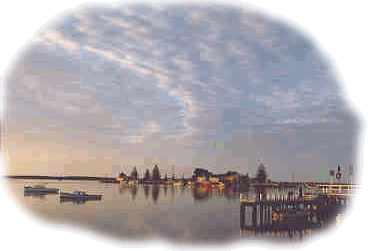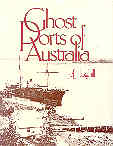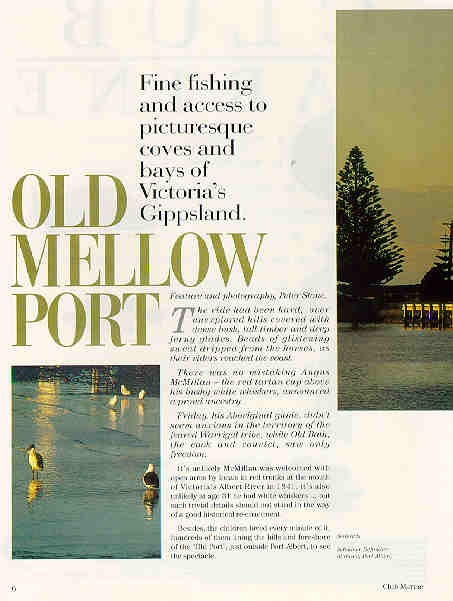|
YARRAM - PORT ALBERT AND DISTRICT South Gippsland
|
 |
|
YARRAM - PORT ALBERT AND DISTRICT South Gippsland
|
 |

|
|
| Despite the fact that it had one of the shortest careers of any trading
port along the east or south coasts of Australia, Port Albert nevertheless
played a very important role in the settlement of the country. Apart from
providing initial access to the magnificent pastoral region of East Gippsland,
for many years it was also the gateway to the gold-diggings high in the
Snowy Mountains at Omeo. At one time one of the most prominent ports between
Sydney and Melbourne, it now shares the fate of the gold-fields, having
slipped into obscurity.
Port Albert has an interesting history which highlights the differences between government and private enterprise in early colonial days. This difference retarded the growth of the country considerably. Investors became reluctant to sink their money into promising schemes, for there was a decided risk that as soon as the project became viable it would be taken over by government instrumentalities with little, if any, compensation. It was this, as much as any other factor, which delayed the development of Port Albert, and although in its heyday it saw much trade pass across its wharves, such prosperity was to be only temporary. The port declined as quickly as it had grown. Although the principal explorers came over the mountains from the north, the first attempts to explore Gippsland were made along the coast. In 1837 and 1838 a vicious drought raged in New South Wales. Settlers desperately sought new pastures and most eyes turned south to more temperate climes. Rumours of magnificent grazing lands locked between the high peaks of the Snowy Mountains and the coastal waters of Bass Strait had long been heard, and many of the southern pastoralists contemplated expeditions to cross the barrier mountains and open up this report paradise. A settler, Andrew Hutton, made the first serious attempt in 1838. He
led a well-organised expedition set up by his employer, the owner of Nungana
Station. A ship was sent ahead round the coast to act as a supply base
for the men and herds of the expedition when they reached their goal. Hutton
worked a herd of 500 cattle down to the coast near the Genoa River, then
attempted
The supply ship, in the meantime, had been wrecked near Wingen Inlet
with the loss of all hands.
But at this point the local Aboriginals again caused problems. The savage Warrigal tribe terrified even the stolid Jimmy Gibber, who turned tail and disappeared into the bush, leaving Macmillan with the unattractive prospect of pushing on alone. The Scot was a shrewd man and saw little future in getting himself killed. He returned to New South Wales and reported his discoveries to Macalister who immediately organised another expedition. Late in 1839 Angus Macmillan led the first white settlers into Gippsland and established a cattle station on the Tambo River. Aware that the hazardous route he had followed through the mountains would not provide a supply route for a new settlement, Macmillan pressed on towards the coast, intent on finding a port which could be developed as a supply base. After more than a year of difficult exploration he located the site of Port Albert and established a base now known as the 'Old Port', close to the site of the present town. This, however, did not resolve all the problems, for discovering a port
site, and getting a port established, were two different things. It began
to look as though all Macmillan's efforts would be to no avail. Then fate
took a hand in the form of the steamer Clonmel, of 700 tonnes, which ran
into difficulties in a storm off the Gippsland coast and was eventually
wrecked at the entrance to Corner Inlet, the waterway in which the newly
discovered 'port' was located. All ninety passengers got ashore safely
and camped on an island, which bears the name of the ship, while a whaleboat
set off for Melbourne to summon help. Two search vessels, the cutters Will
Watch
Their report must have been good. An expedition was mounted and sailed for Corner Inlet to explore the possibilities of establishing a trading port. After weeks of searching for a suitable site this party selected a spot on the banks of the Albert River that was, by remarkable coincidence, exactly the spot chosen by Angus Macmillan and his band only a few weeks before. With both groups unaware of each other's existence, yet selecting the same spot for the location of a port, there was no question that this was the ideal spot. A settlement was established which would later be named Port Albert. Within a month or so, ships began arriving at the new port. The forty-tonne cutter Jane and Emma brought supplies from Melbourne for Macmillan's party, and the schooner Isabella arrived shortly afterwards with a government surveyor, bullocks and stores. Because of the difficult channel, some marker buoys had been laid earlier, but these were blown away in a storm and each ship had to ‘feel' her way up the narrow passage to the new port site. So tricky was the navigation that it took one ship three days from the entrance to the port! The Gippsland Company was the first big firm to establish itself in
Port Albert. It selected over 2000 hectares of land on the west side of
the Albert River, adjoining the reserve area set aside for a government
township, with a view to speculative development. However, Governor Gipps
had something to say about that, as developments were prohibited within
five miles of the site
However, the magnificent hinterland country continued to develop as a prime rural area, and soon its flourishing economy began to improve the fortunes of Port Albert. Shipments of cattle and sheep to Tasmania were made regularly under the supervision of Angus Macmillan who, by this time, was a station owner himself. Incoming shipments of bricks and supplies also helped to establish the small settlement and develop the port. During this period, the centre of activity moved from the original 'Old Port' settlement to a more suitable site nearby, where it exists to this day, and the port began to flourish. In the first six months of 1844 no less than forty-eight ships entered Port Albert, establishing it as an important maritime centre. The fortunes of the town and its port rocketed in the 1850s with the discovery of gold in the mountains behind Gippsland. Wharves, hotels and other official structures appeared, and in the later 1850s the Port Albert Steam Navigation Company was formed with a small fleet of steamers, lighters and tugs. As the only port with access to the gold-fields and the pastoral region of Gippsland, the little port in Corner Inlet was set to carve its name into the history of the nation. Indeed, so meteoric was its rise that plans for a second port at nearby Welshpool were mooted. These did not progress at the time but, by an ironic twist of fate, Welshpool is today the thriving port of Corner Inlet, while Port Albert has sunk to ghost port status. The turning point in the fortunes of the port on the Albert River came
in the 1880s. The gold had petered out, the railway had been pushed through
from Melbourne to Sale, and good roads were being laid through the Latrobe
Valley into the heart of Gippsland. But worst of all, a successful break
through thesand dune barrier of Ninety Mile Beach had opened the Gippsland
Lakes to shipping, and a regular steamer service had commenced between
Melbourne and the Gippsland ports of Bairnsdale, Sale, Metung and Lakes
Entrance. The writing was on the wall for Port Albert, and its decline
was as fast as its rise. Now only a few fishing boats use the port that
once opened up one of Australia's most magnificent pastoral regions and
etched itself into the pages
|
| Chapter 22 from Ghost Ports of Australia, by Jeff Toghill.
The Macmillan Company of Australia, 1984. Copyright Jeff Toghill. Important: Permission to
reproduce the article has not been granted. Macmillan advise that author
Jeff Togill has copyright. An attempt to correspond with Mr Toghill via
his company in Sydney has not met with any response after two letters.
Responsibility for the reproduction of this article lies soley with the
webmaster. The Gippsland Regional Museum, its office bearers and members
are not responsible for the reproduction of the article. It is reproduced
here in the interests and education of the community. No commercial gain
is sought.
|
 |
| WOULD YOU LIKE TO KNOW MORE OF THE
HISTORY OF PORT ALBERT? Enter on the page for an extract from a magazine feature. |
 |
| Find out more about one of Australia's finest artists, Warren Curry. |
| For a range of marine and diving books, contact Oceans Enterprises. |
|
|
|
|
|
|
NEXT |